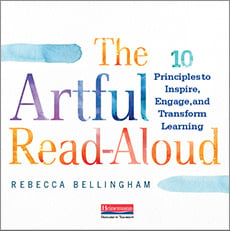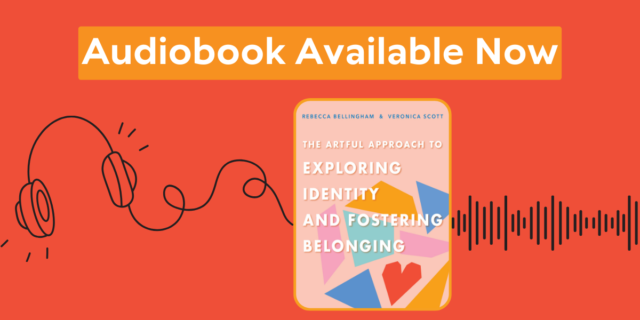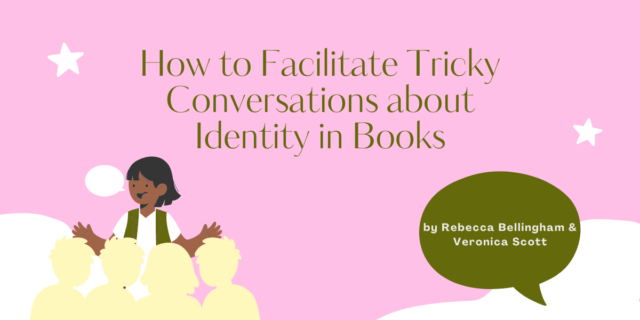
The following is an adapted excerpt from Rebecca Bellingham’s The Artful Read-Aloud. Rebecca and Veronica Scott's new book, The Artful Approach to Exploring Identity and Fostering Belonging.
***
How do we make our teaching, and specifically our read-alouds, more artful? While it is impossible to distill what exactly makes an artistic process successful, The Artful Read-Aloud makes the connection between artistic endeavors and the art of reading aloud, laying out ten principles that teachers can use to make their read-alouds rich with engagement, instruction, connection, and purpose. In any read-aloud, I am not thinking about activating any one principle at any given time; these principles fuel a creative stance—they thread through and elevate my teaching of reading (and other subjects) in general.
Ten Artful Read-Aloud and Teaching Principles
 My work as a literacy educator is informed by a wide range of experiences and collaborations with districts, schools, classrooms, colleagues, kids, artists, arts-based organizations, literacy-based organizations, nonprofits, and think tanks, all of which are cited throughout the book. One specific framework, however, has informed my thinking for years as I’ve developed links between the teaching of reading, and specifically the interactive read-aloud, and creativity. The Ten Capacities for Imaginative Learning, which anchor Lincoln Center Education’s approach to arts education, resonate throughout the book:
My work as a literacy educator is informed by a wide range of experiences and collaborations with districts, schools, classrooms, colleagues, kids, artists, arts-based organizations, literacy-based organizations, nonprofits, and think tanks, all of which are cited throughout the book. One specific framework, however, has informed my thinking for years as I’ve developed links between the teaching of reading, and specifically the interactive read-aloud, and creativity. The Ten Capacities for Imaginative Learning, which anchor Lincoln Center Education’s approach to arts education, resonate throughout the book:
- Notice deeply. How many layers of detail can you identify if you take the time? Can you go deeper? Each artistic principle is informed by noticing deeply and paying close attention—not just to the words or illustrations on the page but to the students in front of you; your own thinking, choices, and emotional responses; and the experience you are helping to shape in the room.
- Embody. Use your body to explore your ideas and to experience a work of art through your senses. Try it out. The principles embody the text and move around are directly linked to this concept, but so too are look up, take a breath, and be awed, all of which discuss the way in which reading aloud makes deep emotional connection possible.
- Pose questions. What do you wonder? The principles make meaning, dig deep, stay open, and invite conversation all address the importance of asking questions and staying open to continued learning between students and also from students. This capacity informs my work when I am teaching students to wonder, but it also reminds me to stay curious whenever I am teaching and learning.
- Make connections. How is this like something else? Make personal, textual, and wider connections. As we read aloud, we make it possible for students to have a rich and deeply engaging experience around text that informs their future reading. Our read-alouds create a shared literary and artistic experience that can be connected to their independent reading throughout the school year, in our conferences and small-group work.
- Identify patterns. How might different details relate? Analyze them. The principles be awed, make meaning, and dig deep value the importance of looking carefully at the details in text through rereading and close reading of the text, the illustrations, an author’s word choice, and an illustrator’s artistic choices.
- Empathize. Can you understand how others think and feel? What are their perspectives? I can think of nothing else that helps children build community and experience the humanity of one another (and the characters whom they grow to know) as well as the interactive read-aloud.
- Live with ambiguity. What if there is not just one answer? Be patient with ambiguity. In a sense, living with ambiguity is part of what makes reading complicated text so challenging, but it is also what I love most about being a reader. Life will always be full of ambiguities and complexities, but book reading creates a quiet space in our brains for contemplating multiple points of view and managing uncertainty, especially as many books do not have tidy endings or circumstances. Modeling how readers navigate complex text, hold onto their questions, and develop and revise their thinking is also one of the most important functions of reading aloud. This idea also relates to our own approach as teachers learning to live with ambiguity as we invite kids into conversation, stay open to their ideas and thinking, and make meaning alongside and in front of them during our read-alouds.
- Create meaning. Bring together what you’ve thought so far. What new interpretations can you make? See these new interpretations in the light of others in the community and express it in in your own voice. This is at the heart of reading aloud—to make meaning in the company of others. The role of the teacher is part facilitator, part reading expert–in-residence, and part artistic collaborator, whose goal is to help students listen and learn from each other and develop ideas in partnership and on their own.
- Take action. What will you choose to do with your ideas? Put them into practice. While move around and dig deep are the most obvious principles that connect to this capacity, the read-aloud energizes students to take action as readers. Students’ desire to take on a more rigorous reading life and their ability to view themselves as thinkers and meaning makers and to see the purpose and delight of books are directly linked to the work we do during the interactive read-aloud.
- Reflect and assess. Look back on what you’ve experienced. What have you learned? What’s next? We are constantly reflecting and assessing as we read aloud to students. Listening in to their talk, looking over their jots or written responses, even paying attention to their body language and engagement all inform our future instruction. When we read aloud, we are creating opportunities to reflect as teachers and giving students opportunities to pause and reflect within themselves, with a partner or small group, or with writing.
When we read—and teach—artfully, we make it practically impossible for students not to fall in love with books and begin to know reading as a personal art themselves. We help students see themselves as readers and see one another as fellow story lovers and human beings who are gathered together to listen, to learn, and to understand the world and all its treasure trove of great characters, big ideas, new information, and life-changing stories a little better.
The Artful Read-Aloud is a user-friendly guide that builds a bridge between the artistic world and the classroom. Rebecca Bellingham draws on her experience as a performer, teaching artist, classroom teacher, and literacy coach to make explicit connections between the arts and reading aloud, providing dozens of easy moves teachers can make that can enhance, elevate, and deepen the impact of interactive read-alouds.

Rebecca Bellingham is a teacher, literacy consultant, college instructor, and performer. After receiving her master's in elementary education at Lesley University through Shady Hill School's Teacher Training course, Rebecca began working as a teaching artist in the South Bronx with DreamYard, a nationally recognized community arts organization. She went on to teach at the Berkeley Carroll School in Park Slope, where she was a fourth-grade teacher and literacy coach. She received a master's degree in literacy specialization at Columbia University Teachers College and began working at Teachers College Reading and Writing Project as a staff developer and later as a full time instructor in the Literacy Specialist program. Currently, Rebecca leads professional development within the San Diego Unified School District, partners with many nonprofit, arts-based and literacy organizations, and continues to teach courses on the integration of the arts and literacy at Teachers College.



